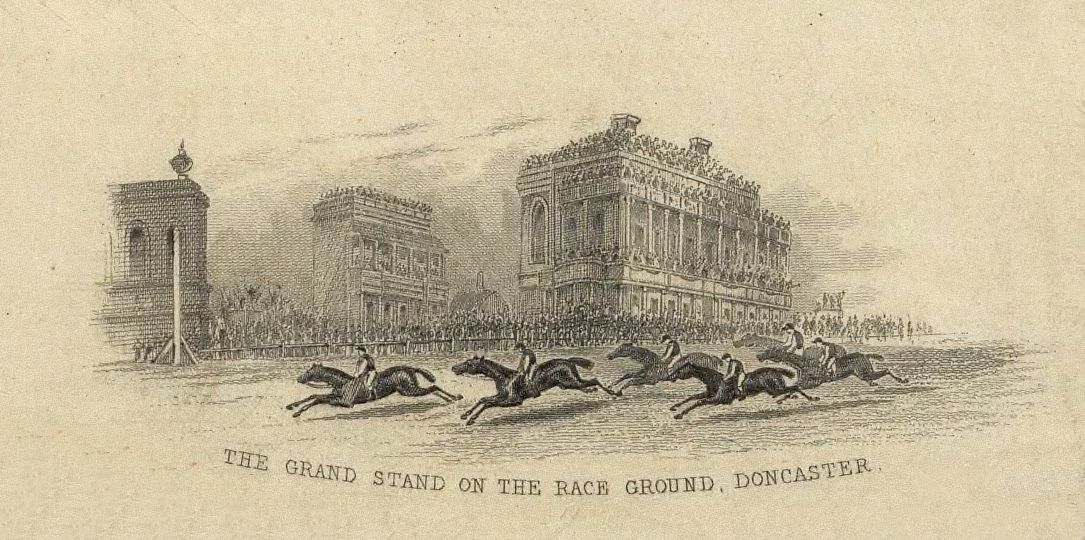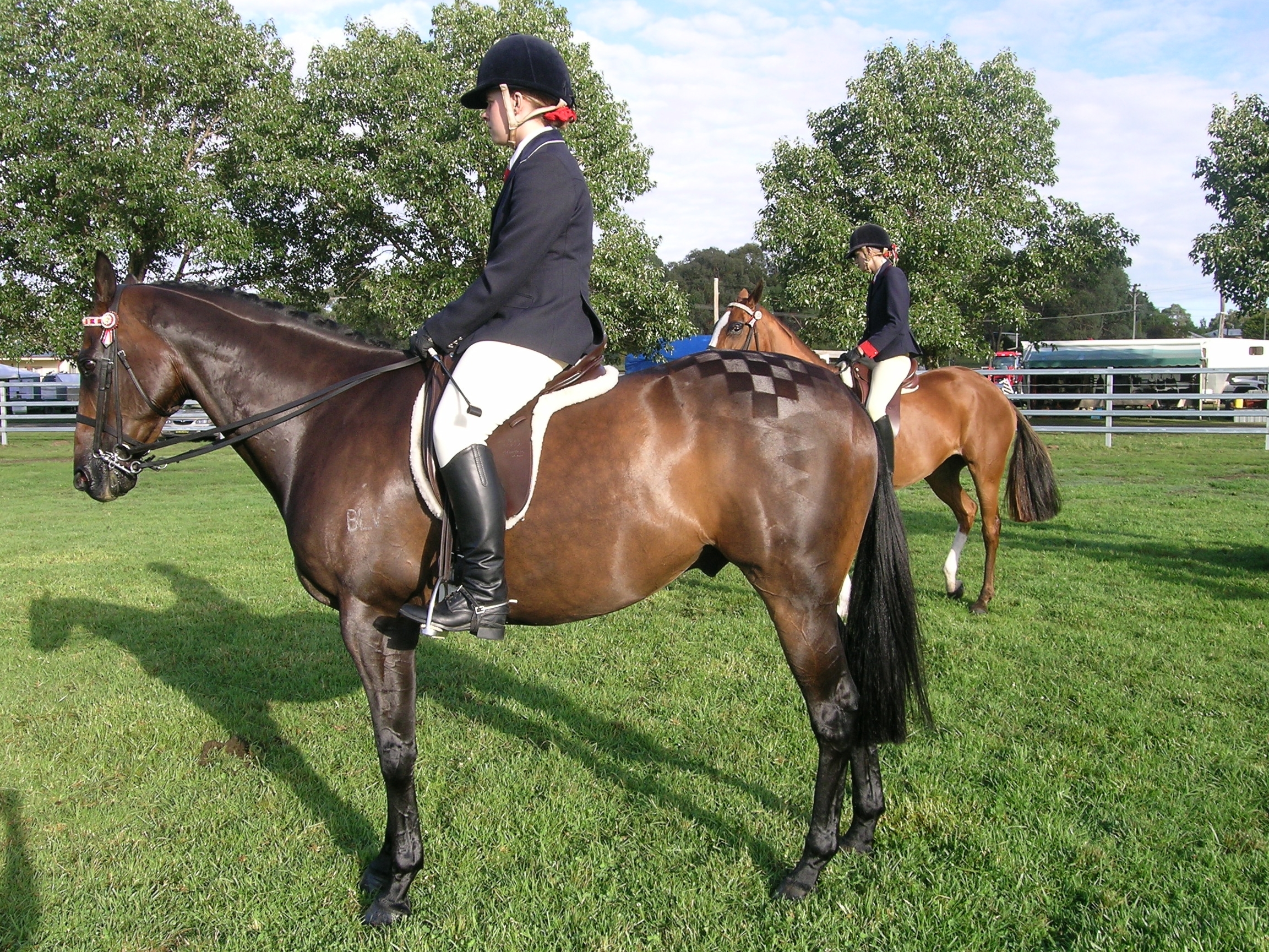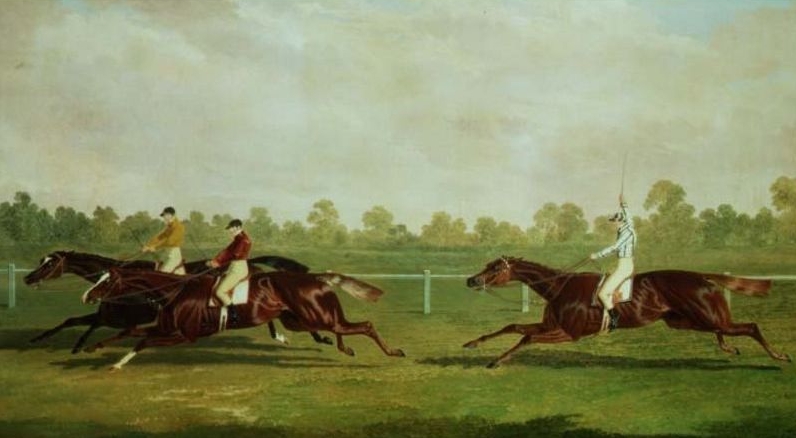|
Ninety-three (horse)
Ninety-three (foaled 1790) was a British Thoroughbred racehorse best known for winning the classic St Leger Stakes in 1793. He was one of the least successful of classic winners, with the St Leger being his only victory in a six race career which lasted from May 1793 until September 1794. After his retirement from racing he does not appear to have been used as a breeding stallion. His name has also been rendered as Ninety three, Ninety Three and Ninety-Three. Background Ninety-three was a chestnut horse bred by John Clifton. He was sired by Florizel, a successful racehorse whose other offspring included The Derby winners Diomed and Eager, as well as the St Leger winner Tartar. Ninety-three was the third of twelve foals produced by his dam Nosegay, a mare bred by the Duke of Cumberland. Before he appeared for his first race, the colt appears to have been sold to Thomas Vernon and then sold again to John Hutchinson. Racing career 1793: three-year-old season ''Mr. Hutchinson's c ... [...More Info...] [...Related Items...] OR: [Wikipedia] [Google] [Baidu] |
Florizel
Florizel (1768–1791) was a Kingdom of Great Britain, British Thoroughbred racehorse. He was a Bay (horse), bay son of Herod (horse), Herod foaled in 1768. As a sire he produced 175 winners who won a total of 75,901 pounds. Offspring included Eager (horse), Eager (winner of the 1791 Epsom Derby, Derby), Tartar (horse, foaled 1789), Tartar (St. Leger), Ninety-three (horse), Ninety-three (St. Leger), Brilliant, Diomed (winner of the Derby and a great sire in the US, producing Sir Archy), Ulysses (horse), Ulysses, Moustrap, and Admiral. Important daughters included Leveret (dam of Lilliput), Fancy (dam of Rattle), Lucy (dam of Skylark), and the dam of Clifden. Florizel died in 1791. 'Florizel' is on the permanent list, of The International List of Protected Names. Lester Piggott, retired jockey, named his house 'Florizel'.House Names of the Rich and Famous http://www.housenameheritage.com/hnh_ng_richandfamous.asp Sire line tree *Florizel **Brilliant **Moustrap **Crookshanks ** ... [...More Info...] [...Related Items...] OR: [Wikipedia] [Google] [Baidu] |
Doncaster Racecourse
Doncaster Racecourse (also known as the Town Moor course) is a racecourse in Doncaster, South Yorkshire, England. It hosts two of Great Britain's 36 annual Group 1 flat races, the St Leger Stakes and the Racing Post Trophy. History Doncaster is one of the oldest (and the largest in physical capacity) established centres for horse racing in Britain, with records of regular race meetings going back to the 16th century. A map of 1595 already shows a racecourse at Town Moor. In 1600 the corporation tried to put an end to the races because of the number of ruffians they attracted, but by 1614 it acknowledged failure and instead marked out a racecourse. Doncaster is home to two of the World's oldest horse races: The Doncaster Cup The earliest important race in Doncaster's history was the Doncaster Gold Cup, first run over Cantley Common in 1766. The Doncaster Cup is the oldest continuing regulated horse race in the world. Together with the Goodwood Cup and Ascot Gold ... [...More Info...] [...Related Items...] OR: [Wikipedia] [Google] [Baidu] |
Tartar (horse, Foaled 1743)
Tartar may refer to: Places * Tartar (river), a river in Azerbaijan * Tartar, Switzerland, a village in the Grisons * Tərtər, capital of Tartar District, Azerbaijan * Tartar District, Azerbaijan * Tartar Island, South Shetland Islands, Antarctica People and languages * Tartar, someone from Tartary, the historical central Asian region populated by Manchus, Mongols, Turks, and others * Tatars, a Turkic ethnic group native to present-day Russia and Ukraine ** Tatar language Chemicals * Potassium bitartrate, also called cream of tartar * Tartaric acid, commonly mixed with sodium bicarbonate and sold as baking powder Food * Steak tartare, a meat dish made from raw ground (minced) beef or horsemeat * Tartar sauce, a condiment primarily composed of mayonnaise and finely chopped capers * Cream of Tartar, the culinary name for potassium bitartrate, a dry, powdery, acidic byproduct of fermenting grapes into wine Military * ''Tartar'' (1813 privateer), an American privateer ... [...More Info...] [...Related Items...] OR: [Wikipedia] [Google] [Baidu] |
Field Hunter
Field may refer to: Expanses of open ground * Field (agriculture), an area of land used for agricultural purposes * Airfield, an aerodrome that lacks the infrastructure of an airport * Battlefield * Lawn, an area of mowed grass * Meadow, a grassland that is either natural or allowed to grow unmowed and ungrazed * Playing field, used for sports or games Arts and media * In decorative art, the main area of a decorated zone, often contained within a border, often the background for motifs ** Field (heraldry), the background of a shield ** In flag terminology, the background of a flag * ''FIELD'' (magazine), a literary magazine published by Oberlin College in Oberlin, Ohio * ''Field'' (sculpture), by Anthony Gormley Organizations * Field department, the division of a political campaign tasked with organizing local volunteers and directly contacting voters * Field Enterprises, a defunct private holding company ** Field Communications, a division of Field Enterprises * Field Museum ... [...More Info...] [...Related Items...] OR: [Wikipedia] [Google] [Baidu] |
Hack (horse)
Hack within the activity of equestrianism commonly refers to one of two things: as a verb, it describes the act of pleasure riding for light exercise, and as a breed (Hackney/hack), it is a type of horse used for riding and pulling carriages.Belknap, p. 224 The term is sometimes used to describe certain types of exhibition or horse show classes where quality and good manners of the horse are particularly important. Etymology It is believed that word originated from Hackney, Middlesex (now absorbed into London), an area where horses were pastured. Historically, the term dates to a time when carriage horses were used for riding. These animals were called "hacks" as a contraction of "hackney", and was originally used to describe an ordinary riding horse, particularly one for hire."Hackney" ''Oxford American Dictionaries'' (Macintosh Widget version) The term also gave a name to a specific horse breed developed in England, known as the Hackney, a lively riding horse which is noted for ... [...More Info...] [...Related Items...] OR: [Wikipedia] [Google] [Baidu] |
Animal Euthanasia
Animal euthanasia (euthanasia from el, εὐθανασία; "good death") is the act of killing an animal or allowing it to die by withholding extreme medical measures. Reasons for euthanasia include incurable (and especially painful) conditions or diseases, lack of resources to continue supporting the animal, or laboratory test procedures. Euthanasia methods are designed to cause minimal pain and distress. Euthanasia is distinct from animal slaughter and pest control although in some cases the procedure is the same. In domesticated animals, this process is commonly referred to by euphemism A euphemism () is an innocuous word or expression used in place of one that is deemed offensive or suggests something unpleasant. Some euphemisms are intended to amuse, while others use bland, inoffensive terms for concepts that the user wishes ...s such as "put down" or "put to sleep". Methods The methods of euthanasia can be divided into pharmacological and physical methods. Accept ... [...More Info...] [...Related Items...] OR: [Wikipedia] [Google] [Baidu] |
Beningbrough (horse)
Beningbrough (1791–1815) was a British Thoroughbred racehorse and sire best known for winning the classic St Leger Stakes in 1794. In a racing career which lasted from May 1794 until August 1797 he won eightof his twelve races. After being beaten on his first appearance, he won his remaining four races as a three-year-old, including the St Leger and the Gold Cup at Doncaster Racecourse in September. He was lightly campaigned thereafter but three times in 1795 and once in 1796. He was then retired to stud where he became a highly successful breeding stallion being the sire and grandsire of many important winners. Background Beningbrough was a bay horse "of great size" bred, owned and trained by John Hutchinson of Shipton, North Yorkshire, and named after a nearby village. He was sired by King Fergus, a successful racehorse who was based at Hutchinson's stud for much of his breeding career. Apart from Beningbrough he was best known as the sire of Hambletonian, who won the ... [...More Info...] [...Related Items...] OR: [Wikipedia] [Google] [Baidu] |
Edward Smith-Stanley, 12th Earl Of Derby
Edward Smith-Stanley, 12th Earl of Derby PC (1 September 1752 ( O.S.) – 21 October 1834), usually styled Lord Stanley from 1771 to 1776, was a British peer and politician of the late eighteenth and early nineteenth centuries. He held office as Chancellor of the Duchy of Lancaster in 1783 in the Fox–North coalition and between 1806 and 1807 in the Ministry of All the Talents. Background and education Derby was the son of James Smith-Stanley, Lord Strange (1716–1771), son of Edward Stanley, 11th Earl of Derby (1689-1776). His mother was Lucy Smith, a daughter and co-heiress of Hugh Smith of Weald Hall, Essex. His father had assumed the additional surname and arms of Smith by private Act of Parliament in 1747. Derby entered Eton College in 1764, proceeding to Trinity College, Cambridge in 1771. Political career Derby was returned to Parliament as one of two representatives for Lancashire in 1774, a seat he held until 1776, when he succeeded his grandfather in the earldom an ... [...More Info...] [...Related Items...] OR: [Wikipedia] [Google] [Baidu] |
Preston, Lancashire
Preston () is a city on the north bank of the River Ribble in Lancashire, England. The city is the administrative centre of the county of Lancashire and the wider City of Preston local government district. Preston and its surrounding district obtained city status in 2002, becoming England's 50th city in the 50th year of Queen Elizabeth II's reign. Preston has a population of 114,300, the City of Preston district 132,000 and the Preston Built-up Area 313,322. The Preston Travel To Work Area, in 2011, had a population of 420,661, compared with 354,000 in the previous census. Preston and its surrounding area have provided evidence of ancient Roman activity, largely in the form of a Roman road that led to a camp at Walton-le-Dale. The Angles established Preston; its name is derived from the Old English meaning "priest's settlement" and in the ''Domesday Book'' is recorded as "Prestune". In the Middle Ages, Preston was a parish and township in the hundred of Amounderness an ... [...More Info...] [...Related Items...] OR: [Wikipedia] [Google] [Baidu] |
Bay (horse)
Bay is a hair coat color of horses, characterized by a reddish-brown or brown body color with a black point coloration on the mane, tail, ear edges, and lower legs. Bay is one of the most common coat colors in many horse breeds. The black areas of a bay horse's hair coat are called "black points", and without them, a horse is not a bay horse. Black points may sometimes be covered by white markings; however such markings do not alter a horse's classification as "bay". Bay horses have dark skin – except under white markings, where the skin is pink. Genetically, bay occurs when a horse carries both the Agouti gene and a black base coat. While the basic genetics that create bay coloring are fairly simple, the genes themselves and the mechanisms that cause shade variations within the bay family are quite complex and, at times, disputed. The genetics of dark shades of bay are still under study. The genetic mechanism that produces seal brown has yet to be isolated. Sooty genet ... [...More Info...] [...Related Items...] OR: [Wikipedia] [Google] [Baidu] |
Nantwich
Nantwich ( ) is a market town and civil parish in the unitary authority of Cheshire East in Cheshire, England. It has among the highest concentrations of listed buildings in England, with notably good examples of Tudor and Georgian architecture. It had a population of 14,045 in 2021. History The origins of the settlement date to Roman times, when salt from Nantwich was used by the Roman garrisons at Chester (Deva Victrix) and Stoke-on-Trent as a preservative and a condiment. Salt has been used in the production of Cheshire cheese and in the tanning industry, both products of the dairy industry based in the Cheshire Plain around the town. ''Nant'' comes from the Welsh for brook or stream. ''Wich'' and ''wych'' are names used to denote brine springs or wells. In 1194 there is a reference to the town as being called ''Nametwihc'', which would indicate it was once the site of a pre-Roman Celtic nemeton or sacred grove. In the Domesday Book, Nantwich is recorded as having eight salt ... [...More Info...] [...Related Items...] OR: [Wikipedia] [Google] [Baidu] |
Doncaster Cup
The Doncaster Cup is a Group 2 flat horse race in Great Britain open to horses aged three years or older. It is run at Doncaster over a distance of 2 miles 1 furlong and 197 yards (3,600 metres), and it is scheduled to take place each year in September. History The event was established in 1766, and it was originally called the Doncaster Gold Cup. It pre-dates Doncaster's St. Leger Stakes by ten years, and is the venue's oldest surviving race. It was initially held at Cantley Common, and moved to its present location in 1776. During the early part of its history the race was contested over 4 miles. It was shortened to 2 miles and 5 furlongs in 1825, and reduced to 2 miles and 2 furlongs in 1891. It was cut by another furlong in 1908, and restored to its previous length in 1927. The present system of race grading was introduced in 1971, and for a period the Doncaster Cup was classed at Group 3 level. It was promoted to Group ... [...More Info...] [...Related Items...] OR: [Wikipedia] [Google] [Baidu] |







